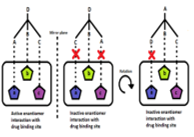Abstract
The chiral separation of pharmaceutical molecules and their precursors is one of the important areas of application of HPLC in pharmaceutical analysis for obtaining the enantiomerically pure drug. The latter procedures include the use of so-called chiral selectors to recognize and isolate the enantiomer enantio-selectively. The direct approaches, i.e., those who do not derivate the compound of interest before separation, are addressed in detail since they are now the most common approaches. The role of stereochemistry in medicinal products is being given greater emphasis on medical practice. For physicians to make a conscious choice about the use of single-enantiomered medicinal products, basic knowledge is required. For a few treatments, single-enantiomer formulations can provide more selectivity than a combination of enantiomers in their biological purposes, enhanced therapeutic indexes and/or better pharmacokinetics. This highlights the possible biological and pharmacological variations between the two drug enantiomers and underlines the clinical experience of individual enantiomers. Particular emphases have been put on chiral separation by HPLC on chiral stationary phases (CSPs). Chiral derivatization reagents (CDRs) are optically pure reagent on reaction with drugs forms a pair of diastereoisomers that can be separated on conventional achiral phase. In the Chiral mobile phase additive (CMPA) method, the stationary phase is achiral and the chiral selector is dissolved during the mobile period. Interaction with the analyte’s enantiomer leads to the formation of transient diastereomeric complexes that are separated by their affinity towards mobile/stationary phase. Separation mechanisms and method development for chiral molecules using these phases are discussed in this review.
Full text article
Authors

This work is licensed under a Creative Commons Attribution-NonCommercial-NoDerivatives 4.0 International License.

